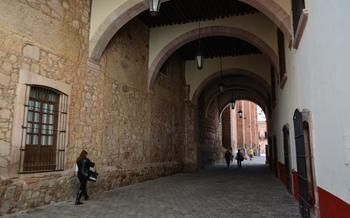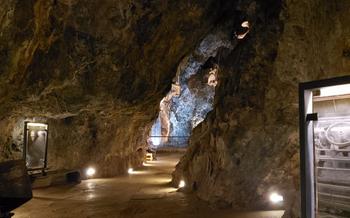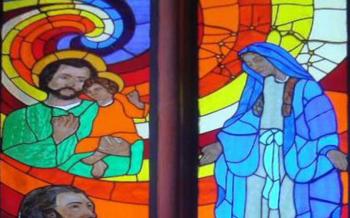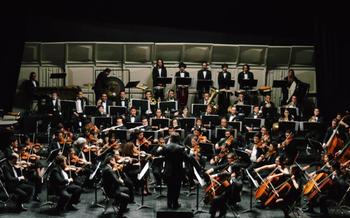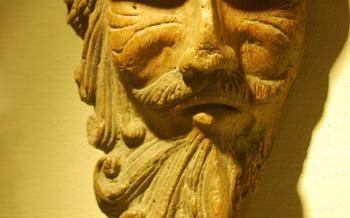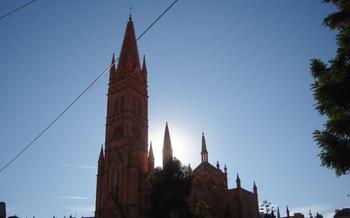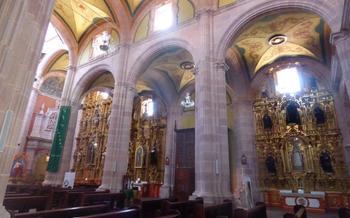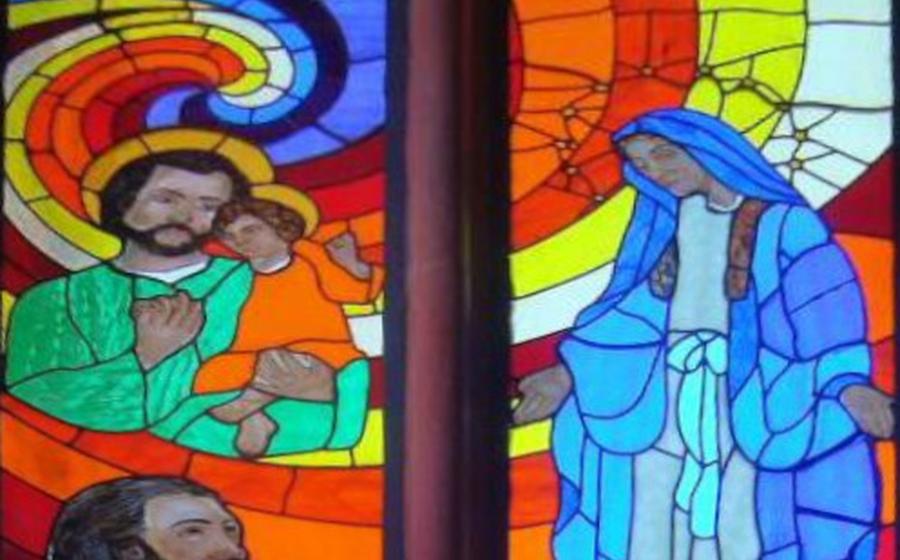
Church of Our Lady of Fátima
- The Church of Our Lady of Fátima: A Majestic Architectural Marvel
- Location and Accessibility: Finding the Sanctuary
- Hours of Operation and Admission Fees: Planning Your Visit
- Historical Significance: A Journey Through Time
- Architectural Highlights: A Visual Feast
- Religious Significance: A Place of Pilgrimage
- Things to See and Do: Exploring the Church Grounds
- Cultural Importance: A Reflection of Zacatecas's Heritage
- Local Community: A Source of Pride and Unity
- Pilgrimage Season: A Time of Faith and Celebration
- Photography and Videography: Capturing the Beauty
- Wheelchair Accessibility: Ensuring Inclusivity
The Church of Our Lady of Fátima: A Majestic Architectural Marvel
Nestled in the heart of Zacatecas, Mexico, the Church of Our Lady of Fátima stands as a testament to architectural grandeur and religious devotion. Its history dates back to the mid-20th century when a group of faithful Catholics, inspired by the apparitions of Our Lady of Fátima in Portugal, embarked on a mission to build a sanctuary dedicated to her.
Constructed in the Neo-Gothic style, the church boasts an awe-inspiring facade adorned with intricate stone carvings, intricate stained glass windows, and two towering bell towers that pierce the sky. The interior is equally captivating, with vaulted ceilings, elegant arches, and a series of side altars dedicated to various saints.
Beyond its architectural beauty, the Church of Our Lady of Fátima holds immense significance as a religious and cultural landmark in Zacatecas. It attracts pilgrims from far and wide who pay homage to Our Lady of Fátima and seek spiritual solace within its hallowed walls. The church also serves as a vibrant community hub, hosting regular masses, celebrations, and events that bring the local faithful together.
Location and Accessibility: Finding the Sanctuary
The Church of Our Lady of Fátima stands as a beacon of faith and architectural wonder, nestled in the heart of Zacatecas's historic center. Its exact address is Avenida Hidalgo No. 614, in the Guadalupe neighborhood. To reach this sacred haven, visitors can navigate using the GPS coordinates of 27682° N, 105804° W.
In the immediate vicinity, several notable landmarks beckon, inviting travelers to explore Zacatecas's rich tapestry of history and culture. The iconic Zacatecas Cathedral, a magnificent edifice of Baroque splendor, lies just a short stroll away, while the Rafael Coronel Museum, showcasing a remarkable collection of Mexican folk art, is also within easy reach.
Transportation options are plentiful, ensuring seamless access to the church. Public buses traverse the city, offering convenient connections to the church's doorstep. For those seeking a more leisurely approach, cycling is an excellent option, as designated bike lanes provide a safe and scenic journey. Ample parking spaces are available nearby, accommodating visitors arriving by car.
Venturing beyond the church's immediate surroundings, a wealth of attractions awaits exploration. The enchanting Jardín Juárez, with its verdant oasis and vibrant ambiance, is a mere stone's throw away. The fascinating Toma de Zacatecas Museum, chronicling the city's heroic struggle for independence, is also within easy walking distance.
Whether arriving on foot, by bike, or by car, the Church of Our Lady of Fátima is effortlessly accessible, inviting pilgrims and sightseers alike to immerse themselves in its spiritual and architectural grandeur.
Hours of Operation and Admission Fees: Planning Your Visit
The Church of Our Lady of Fátima welcomes visitors and worshippers daily, providing ample opportunities for exploration and reflection. Regular operating hours are from 8:00 AM to 6:00 PM, allowing ample time to immerse yourself in the church's beauty and history. Special event hours may apply during religious festivals or holidays, so it's advisable to check the church's website or contact the parish office for specific information.
Admission to the church is free of charge, allowing everyone to experience its grandeur without financial barriers. Guided tours are available for those seeking a deeper understanding of the church's history, architecture, and religious significance. These tours are typically led by knowledgeable guides who share fascinating insights and anecdotes, enhancing the overall visitor experience.
For those visiting during peak tourist season or during special events, it's recommended to arrive early to avoid crowds and fully appreciate the church's serene atmosphere. Remember to dress respectfully and maintain silence while inside the church, respecting the religious nature of the space.
Historical Significance: A Journey Through Time
The Church of Our Lady of Fátima stands as a testament to Zacatecas's rich religious and cultural heritage. Its foundation in the early 18th century marked a pivotal moment in the city's history, as it became a symbol of faith and devotion for the local community. Over the years, the church has undergone several renovations and expansions, each contributing to its architectural evolution and reflecting the changing tastes and needs of its congregation.
The church played a significant role in Zacatecas's religious and cultural history, serving as a center for worship, education, and community gatherings. It witnessed numerous religious festivals, processions, and celebrations, becoming an integral part of the city's social and spiritual fabric. Local legends and folklore surrounding the church add to its mystique, further enriching its historical significance.
One of the most captivating aspects of the church's history is its association with the apparition of Our Lady of Fátima in Portugal in 191This event deeply impacted the local community, leading to the construction of a replica of the Portuguese sanctuary within the church grounds. The replica became a popular pilgrimage site for devotees seeking solace, guidance, and blessings, further solidifying the church's status as a sacred destination.
Throughout its existence, the Church of Our Lady of Fátima has undergone various renovations and restorations, each aimed at preserving its architectural integrity while adapting to the evolving needs of its congregation. These renovations have ensured that the church remains a vibrant and functional place of worship while safeguarding its historical significance for future generations.
Architectural Highlights: A Visual Feast
The Church of Our Lady of Fátima proudly showcases a captivating blend of architectural styles, making it a feast for the eyes. Its distinctive facade, adorned with intricate carvings and sculptures, narrates the stories of saints and biblical scenes. The majestic bell towers, piercing the azure sky, chime harmoniously, calling worshippers to prayer.
Step inside the church, and you'll be awestruck by the resplendent interior decorations. The walls are adorned with vibrant murals depicting religious scenes, each brushstroke infused with devotion. The intricately carved altars, adorned with gold leaf and precious stones, shimmer under the soft glow of flickering candles.
Gaze upon the magnificent stained-glass windows, which transform the sunlight into kaleidoscopic hues, bathing the interior in a celestial radiance. Each window tells a story from the Bible, showcasing the lives of saints, the miracles of Jesus, and the grandeur of God's creation.
Explore the church's unique architectural elements, which reveal the ingenuity and artistry of its builders. From the ornate vaulted ceilings to the graceful arches, every detail exudes a sense of grandeur and reverence. Discover the hidden symbolism woven into the design, where each element represents a deeper spiritual meaning.
Religious Significance: A Place of Pilgrimage
The Church of Our Lady of Fátima holds immense religious significance as a pilgrimage site for devout Catholics. Dedicated to Our Lady of Fátima, the church attracts pilgrims from all corners of Mexico and beyond who seek spiritual guidance and blessings. The annual pilgrimage season, which typically falls between May and October, is a time of great fervor and devotion. During this period, the church welcomes thousands of pilgrims who participate in special masses, processions, and other religious events.
The church's reputation as a sacred place is deeply rooted in the belief that Our Lady of Fátima appeared to three shepherd children in the small village of Fátima, Portugal, in 191The children reported that the Virgin Mary delivered messages of peace, repentance, and prayer to them. These apparitions and the subsequent miracles attributed to Our Lady of Fátima have made the church a popular destination for pilgrims seeking divine intervention and spiritual renewal.
Things to See and Do: Exploring the Church Grounds
The Church of Our Lady of Fátima offers visitors a variety of things to see and do, both inside and out. Guided tours led by knowledgeable guides are available, providing visitors with insights into the church's history, architecture, and religious significance. Self-guided exploration is also encouraged, allowing visitors to take their time admiring the church's interior and exterior. The church's interior is adorned with stunning artwork, statues, and religious artifacts that tell the story of Catholicism in Zacatecas. Visitors can light a candle and offer prayers for guidance and blessings, creating a deeply personal and spiritual experience. The church grounds also feature a peaceful courtyard where visitors can sit and reflect, taking in the tranquility of this sacred space.
Cultural Importance: A Reflection of Zacatecas's Heritage
The Church of Our Lady of Fátima stands as a testament to Zacatecas's rich cultural traditions. Its architectural grandeur, intricate artwork, and religious significance have left an indelible mark on the city's cultural landscape. The church's presence has influenced local art, music, and literature, inspiring countless works that celebrate Zacatecas's unique heritage.
Moreover, the church is an integral part of Zacatecas's historical fabric. It has witnessed the city's evolution over centuries, serving as a backdrop for countless events that have shaped Zacatecas's identity. The church's preservation and promotion of cultural heritage play a vital role in strengthening the city's sense of place and fostering a sense of pride among its residents.
Local Community: A Source of Pride and Unity
For the people of Zacatecas, the Church of Our Lady of Fátima holds immense significance, deeply entwined with their cultural identity and sense of community. It serves as a spiritual and social hub, fostering a deep connection among the local residents. The church is a place where they gather for celebrations, festivals, and events, strengthening their bonds and reinforcing their shared heritage. Its presence has played a pivotal role in shaping Zacatecas's unique cultural landscape, making it an integral part of the city's fabric and a symbol of unity and belonging for all Zacatecans.
Pilgrimage Season: A Time of Faith and Celebration
The pilgrimage season at the Church of Our Lady of Fátima is a time of great spiritual significance for devotees. From March to June, the church welcomes thousands of pilgrims who come to pay homage to Our Lady of Fátima and seek her blessings. During this period, special masses, processions, and devotional practices are held at the church, creating a vibrant atmosphere of faith and celebration. Pilgrims often travel long distances to visit the church and participate in these special events.
For those planning to participate in the pilgrimage, it is advisable to book accommodation in advance, as the city tends to be crowded during this time. The church provides various facilities to cater to the needs of pilgrims, including designated prayer areas, rest stops, and food stalls. For a truly immersive experience, join the processions that take place in the streets of Zacatecas, where pilgrims carry colorful banners and statues of Our Lady of Fátima. It is a sight to behold and a testament to the deep devotion that the people of Zacatecas have for their patron saint.
Photography and Videography: Capturing the Beauty
The Church of Our Lady of Fátima presents a plethora of photo opportunities, both inside and out. The intricate details of the facade, the towering bell towers, and the manicured gardens provide a stunning backdrop for capturing memorable shots. Inside, the resplendent stained glass windows, ornate altars, and delicate frescoes create an awe-inspiring visual feast.
When taking photos and videos within the church, it is essential to be respectful of the sacred space and its visitors. Using a tripod or flash is generally discouraged, as they can be disruptive during religious services or prayer time. Prioritize natural lighting to capture the church's beauty without disturbing its serene atmosphere.
Beyond capturing the church's physical grandeur, strive to convey its spiritual essence through your lens. Photograph the flickering candles, the bowed heads of worshippers, and the radiant expressions of pilgrims. These candid moments will help you narrate the story of faith and devotion that permeates this holy sanctuary.
Wheelchair Accessibility: Ensuring Inclusivity
The Church of Our Lady of Fátima is committed to providing an inclusive and accessible environment for all visitors, including those with disabilities. Wheelchair ramps and accessible entrances have been installed to ensure that everyone can enter and explore the church without any barriers. Designated parking spaces are also available for people with disabilities, located conveniently close to the church entrance. For those who require additional assistance, assisted tours or special accommodations can be arranged upon request. The church staff is always willing to help and make sure that everyone has an enriching and fulfilling experience during their visit.
